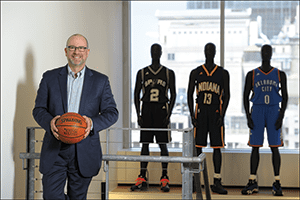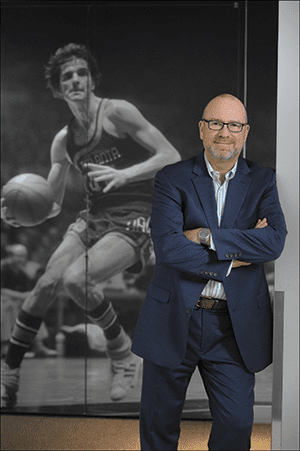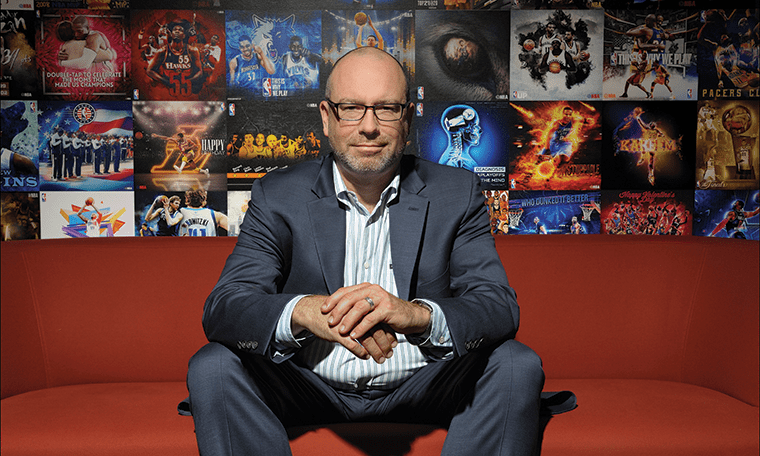When Mike Kennedy joined the National Basketball Association in 2012 as director of learning and leadership development, the organization was stuck in an old-school learning environment under long-time commissioner David Stern.
The curriculum was limited, managers decided whether their people attended courses, and there was no clear vision of what effective leadership looked like.
“Leadership development was seen as a perk rather than a strategy,” Kennedy said.
Over time that affected employee engagement and retention among the association’s 1,500 employees, Kennedy said. There were many long-time employees who were loyal to Stern’s way of doing things, and new hires, who still came in enamored with the idea of working for the NBA, often left after a few years.
“We were bleeding talent and it had become tough to get midlevel work done,” he said. Kennedy himself had begun to wonder if he could build a long-term career in that kind of environment.
Then everything changed.
In 2014, Adam Silver, then NBA deputy commissioner and chief operating officer, took over as commissioner and brought a fresh approach to management and talent development. From the start, Silver was acknowledged as a more inclusive leader who sought out opinions and strove to make the NBA a place where people were “overjoyed to come to work,” said Eric Hutcherson, NBA senior vice president, people and culture.
“He doesn’t just want it to be the world’s greatest sports league, he wants it to be the best organization in the world,” he said.
An MBA for the NBA
Silver recognized that the NBA was already great at executing tasks core to the business like broadcasting games and managing teams. But he wanted to focus on expanding the skill set of the workforce and to be more intentional in the way people are recruited and managed across the organization, Kennedy said.
“He saw a big opportunity to do things differently in human capital management,” he said.
Kennedy, who is now associate vice president of talent and learning, would play a key role in that transformation. In Silver’s first year, he hired Hutcherson, eliminated some HR roles and split the learning and development department into two groups, putting Kennedy in charge of leadership and employee development. Silver also increased the training budget and encouraged Kennedy to build a new program that would address the needs of leaders at every level.

“Mike had the philosophy, ability and desire to build a great leadership program,” Hutcherson said. “He just needed permission to do it.”
Kennedy’s plan was to start with a strategic development forum for high-potential leaders that would give them the skills and support to be successful NBA leaders. The program would support managers whose performance and potential suggested a high likelihood of rapid career growth with a particular focus on rising stars who executives were most concerned about losing. He would later expand the program to leaders across the organization.
“I had to pitch it but there was hunger in many corners of the organization for a program like this one,” Kennedy said.
That hunger grew as Silver made new hires, bringing in thought leaders from companies like McKinsey & Co., The Walt Disney Co. and Accenture to round out the staff. “They stoked the appetite for learning and that helped influence support,” he said.
Silver and Hutcherson backed Kennedy’s plan and over the following year Kennedy devoted much of his time to building the leadership curriculum, which he likens to a mini-MBA program.
The curriculum focuses on four leadership levels — incoming managers, directors, vice presidents and advanced leaders — and includes 70 hours of intensive strategic development over five to seven months.
“Throughout the program, participants work in communities of practice to propose solutions to strategic issues and build networks that support long-term success,” Kennedy said. The Rising Talent Track is designed for midcareer leaders while the Veteran Track brings together participants at the vice president level.
Development includes experiential learning activities and real-life case studies grounded in the NBA experience. Participants are encouraged to bring specific challenges from their own team to discuss and most modules are taught by NBA leaders along with a few business school professors. This approach ensures the content and discussions are specific to the NBA and helps participants expand their network.
That added real value for Mike James, senior director, team marketing and business operations strategy and analytics, who was among the first cohort to complete the program in 2015. “If you are going to be a future leader, you need to build a network with people outside of your own team,” he said. “That aspect of the program was particularly illuminating.”
Early in his career, James opted not to get an MBA and had been feeling frustrated about his growth opportunities since but Kennedy helped him chart a new course.
“Five years ago, I didn’t know what good leadership development looked like but Mike laid it out for us,” he said. “Having the ability to take a curriculum that aligns with NBA goals was definitely what I needed.”
Leaders in the Classroom
One of the unique aspects of Kennedy’s leadership style is his hands-on approach. Throughout his career, which includes stints at professional services firm KPMG and luxury retailer Tiffany & Co., Kennedy has always prioritized spending time in the classroom. To him, it’s an important way to gauge employee response to training programs and let participants know he is committed to their growth.
That continues today. Along with developing curriculum and working with vendors, Kennedy regularly teaches courses, leads train-the-trainer workshops and works one-on-one with individual leaders and their managers to make sure they are getting what they need to excel. Hutcherson said his constant presence set the tone for the new development program.
“Participants see the level of commitment to learning and that makes them want to up their game,” he said.

It also gives Kennedy insight into the strengths and weaknesses in the leadership pool, which helps him shape content and advise the executive team about succession planning.
“He has firsthand knowledge of which high performers have the potential to be great leaders,” Hutcherson said. “It gives us a much better sense of who will be the most capable in a new role.”
That has helped the organization make better promotion decisions and avoid having to shift people out of roles they aren’t suited for. Program participants like it as well.
“It really helped to have Mike in the classroom because he knows how to get people engaged,” James said. “Even when he’s just observing, it conveys the message that he cares about our development.”
Kennedy wasn’t the only one conveying the NBA’s commitment to learning. Silver also stepped up, spending time in the classroom and urging leaders who were more resistant to change to participate in the program.
“Adam’s influence was very effective,” Kennedy said. More leaders are applying for the program and sponsoring their people to participate, which in turn is starting to affect the leadership culture in the organization.
Since completing the program, James said he is more conscious of his leadership style and the way he supports his team. He now actively looks for opportunities to better himself — and Kennedy is there with options. After Kennedy built out the leadership forum, his department began rolling out new live and online classes to support ongoing employee development and accommodate growing demand for training at all levels.
Kennedy also led an expansion of content offerings, working with more than 40 vendors to roll out a range of new content from short online courses to day-long workshops. The curriculum includes ongoing development courses for alumni of the strategic development forum to further their growth as leaders.
James has completed four of them this year alone. “I’ve done more to develop myself in the past 18 months then I had in my career,” James said. “It is helping me learn what it means to be a good leader.”
James is not alone. In the two years since launching the program, there has been a 300 percent increase in professional development and 100 leaders have completed the forum. That includes many senior leaders who were initially gun-shy about setting aside whole days to participate in training.
When they saw peers getting recognized by Silver and other executives in meetings and company communications, they wanted to get involved. “Peer pressure is an amazing tool in that regard,” Hutcherson said.
He Shoots, He Scores
Kennedy estimated the leadership program now reaches approximately one-third of all NBA people managers and 50 high-potential employees every year. And while he doesn’t put a lot of stock in linking learning programs directly to bottom-line results, he has seen higher retention among leaders who’ve gone through the program and steadily rising rates of engagement and employee satisfaction in annual surveys, a key metric for Silver.
Engagement scores have climbed from the low 70s to the mid-80s in three years, Hutcherson reported. He hopes to exceed 90 percent next year — a benchmark for being ranked as a Great Place to Work. “We are still evolving, and every year we get better,” he said.
While Kennedy attributes much of the success to the support he received from Silver, Hutcherson and other leaders, he also believes he was uniquely suited to make this transformation a success.
“I have a knack for finding solutions outside of the mainstream,” he said. Having worked in prior jobs with small teams and limited budgets helped him figure out how to be creative and deliver results quickly.
Hutcherson agreed, saying Kennedy plays a crucial role in achieving Silver’s vision of transforming the NBA into a world class organization where employees feel valued and invested in.
“Our people see that we are making a commitment to developing them,” Hutcherson said. “That makes them feel valued, but it also makes them feel like they need to keep getting better.”
At the end of the day, Hutcherson said you need great people to make a great organization and the way to do that is to build a culture of continuous improvement.
“Mike did more than just create a training program,” he said.
Sarah Fister Gale is a writer based in Chicago. Comment below or email editor@CLOmedia.com.















